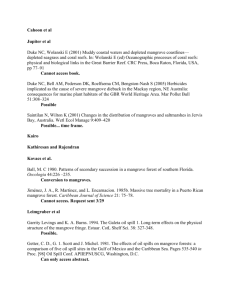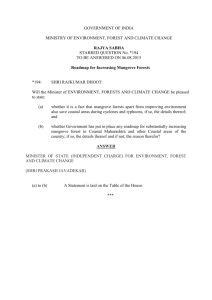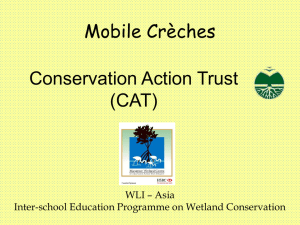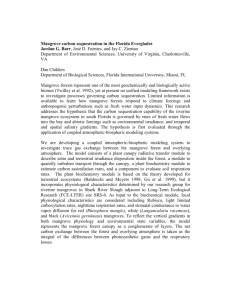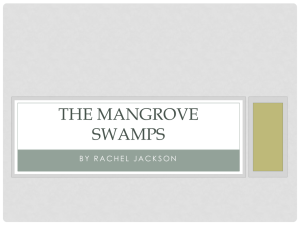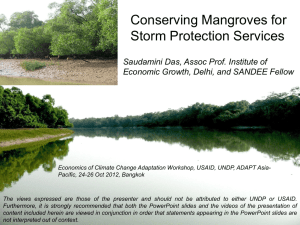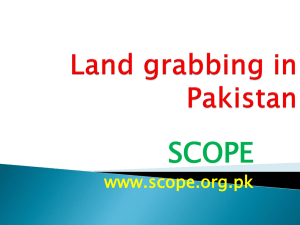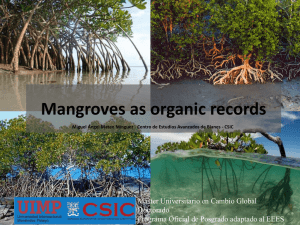Management of Mangrove Forests by Sindh Forest - WWF
advertisement
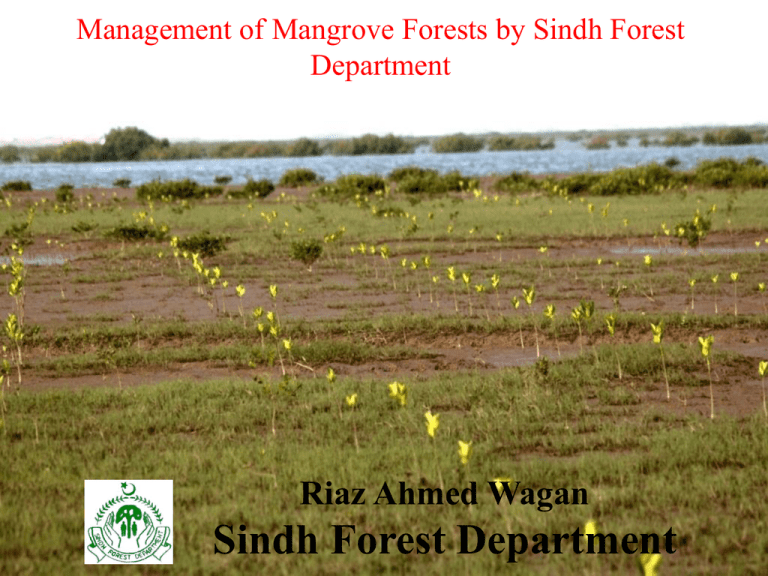
Management of Mangrove Forests by Sindh Forest Department Riaz Ahmed Wagan Sindh Forest Department Extent of Pakistan’s coast The Pakistan’s coast is about 1050 km long extending from the Indian border on the east to the Iranian border in the west. The Exclusive Economic Zone (EEZ) of Pakistan is about 240,000 sq. km with an additional continental shelf area of about 50,000 sq. km. As such, the total maritime zone of Pakistan is over 30% of the land area NIO 2011). Coastal Resources of Sindh In Sindh, mangroves of the Indus Delta are present in the districts of Thatta and Karachi; However deltaic area devoid of mangroves is also present in Badin district as well. Early records show eight species of mangroves exist along the delta. Presently only four are found i.e. Avicennia marina, Rhizophora mucronata, Aegiceras corniculatum and Ceriops tagal Ownership status of the Mangroves Organization / Legal Status of Indus delta Area Department (Hectares) Sindh Forest Department 280,470 Protected Forests (1958) Sindh Board of Revenue 260,000 Protected Forests (Nov. 2010) Port Qasim Authority 64,400 Protected Forests (1958) Karachi Port Trust 2,000 Protected Forests (Nov. 2010) Total 606,870 Coastal Resources of Pakistan MANGROVES: The Indus delta mangrove ecosystem is spread over 600,000 hectares SUPARCO in 2009 estimated, the total covered mangrove forest area along the Coast of Sindh as107,640 hectares, out of which the mangrove forests at Karachi harbour area are spread over 1,160 hectares and in Indus Deltaic region, over an area of 106,480 ha. About 7500 hectares of Mangroves exist in Baluchistan coast Mangrove Species of Indus Delta Avicennia marina (Teemur) Rhizophora mucronata (Kumri) Ceriops tagal (Kiriri) Aegiceras corniculatum (Chaunr) Coastal Resources of Pakistan cont FISHERIES: The deltaic networks of creeks are a major breeding area for commercially important coastal fisheries that include shrimps, finfish, crabs etc with average export value of US $110 million a year. The annual average catch of Shrimps from Sindh coast is 27,500 tons (35 times larger) whereas, from Balochistan is 800 tons The annual Finfish harvest in Sindh is 231,000 tons as compared with 103,000 tons of Balochistan Economic importance of mangroves Important supplier of nutrient and oxygen Nurseries for many species of fish and shrimp Stabilize shorelines and reduce coastal erosion Protect coastal areas from storm damage Act as carbon sinks One ha of properly managed mangroves can yield annually 100 kg of Fish, 25 kg of Shrimp and 15kg of Crab meat (IUCN 2005) In Dollars terms Direct Valuation = $ 37500/ha (Fishery and Forestry products) Indirect Valuation = $ 1700/ha (Protective services) Coastal livelihoods The human population in and around mangrove forests on the coast of Pakistan is estimated to be about 1.2 million. Nearly 900,000 reside in the Indus Delta and 300,000 on the Baluchistan Coast. The number of households is estimated to be about 140,000 in the Indus Delta and 30,000 on the Baluchistan Coast Coastal Population of about 210,000 is directly dependant on coastal resources About 90% of the households in the coastal communities rely on fishing and other fisheries related activities(Siddiqi et.al 2007). Coastal livelihoods contd A diagnostic survey of Indus delta shows that 25% of households depend on Mangrove wood for cooking & heating purpose. Each family uses 173 kg. of mangrove wood per month giving a total annual consumption of 18,000 tons. It is estimated that a total of 6,000 camels and 3,200 cattle are using the ecosystems resources and consume about 19.5 m kg of grasses and 67 million kg of leaves annually. Coastal Livelihoods contd Conservation & Rehabilitation Initiatives By Sindh Forest Department spread over 25 Years Activity Achievement Planting on Blank Mudflats 31, 400 Ha. Planting on High Lying Mudflats 4, 000 Ha. Planting to Assist Natural Regeneration 15, 632 Ha. Total Planted Species _________ 50, 032 Ha. Avincennia marina; Rhizophora mucronata & Ceriops tagal Current and Future Plans of SFD Following development projects are underway: Planting of Mangroves over 5000 hectares in Board of Revenue and Port Qasim areas Planting of Mangroves over 8000 hectares in Keti Bandar and Shah Bandar areas with the assistance of Asian Development Bank One new project on climate change and Sea intrusion effects is ongoing. Spanning over a seven year period, mangrove plantations over 50,000 Ha. would be developed/raised by Sindh Forest Department. A Joint project with IUCN on mangroves is also under consideration in Keti Bundar and Kharo Chan areas. Evident changes in mangrove coverage Conservation initiatives 25 Years contd. Pioneer Work: SFD is the pioneer in scientific management of Mangroves in Pakistan. The most important achievement is the re-introduction of an extinct tree species from Indus delta, Rhizophora mucronata. The spp. has successfully established to an extent that enough seed is available for planting operations from local source. Now trial planting of near extinction spp. Ceriops tagal is underway Research: Socio-economic Survey; Species survival rates studies, etc. Awareness Raising: Activities carried out with the collaboration IUCN Pakistan, WWF Pakistan & NRSP Education: Through demonstration Plots and Nursery raising techniques, publicity and printing materials etc Guinness World Record: The July 2009 record set for planting 541,176 Rhizophora plants Community Participation Mangrove Restoration activities Community Participation in Mangrove Restoration activities Mangrove Protection and Awareness Raising Activities Mangrove Protection and Awareness raising activities contd- Mangrove Protection and Awareness raising activities contd- Community Protection Model Sindh Forest Department is protecting newly planted mangrove forests through a family unit by paying a monthly sum of Rs. 6000/family for every 60 hectares of plantation. This arrangement helps in effective protection, conflict resolution and offers direct financing option to coastal communities. In future such plantations would be a source of carbon credit earnings for poor communities of the coastal belt Plantations Raised by SFD in Keti Bundar area Three- Year Old Avicennia Plantation Five-Year Old Rhizophora Plantation Mangrove Plantation at Keti Bandar Established Mangrove Plantations Mangrove Plantation at Shah Bandar Threats to Mangroves Shortage of required fresh water and silt depositions from River Indus have enhanced salinity levels in the delta Sea intrusion and erosion in the delta caused by sea level rise Encroachment for settlements around Karachi mangroves Industrial and municipal pollution, dumping of waste, oil spills and leakages Over exploitation of mangroves for fuel wood/fodder Grazing and Browsing by Camels Proposed Strategy Threat Recommendation Responsibility Insufficient water flow down- Ensure sufficient water flow stream Kotri Barrage Industrial and Municipal Pollution Ensure water treatment plants are operational and environmental regulations are followed Irrigation Dept: stakeholders SEPA, provincial Government Oil-spill and leakages SEPA, Maritime security agencies Sea-level rise Strict monitoring and adoption of a disaster management strategy Research into the affect of climate change and setting up on monitoring cell and all and local SEPA, Ministry of Env (Global Change Impact Study Centre). Field level interventions by SFD through biological control mechanism. NGOs etc Encroachment for settlements Enforcement of laws Sindh Police, Sindh Forest Dept, PQA, KPT. Cutting for fuel-wood and fodder Enforcement of laws, raising new Sindh Forest Dept, NGO’s, plantations and provision of provincial govt. alternate sources of wood and energy Awareness in local people, Massive awareness campaign is NGOs, Media and Government politicians and general public required Organizations THANK YOU
